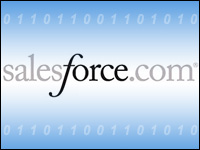
Salesforce.com’s Spring ’07 release, specifically the AppSpace product, is being hailed as a quantum leap forward in functionality that will support users in fulfilling their corporate missions.
AppSpace, which hasn’t been activated as yet, is a new product that provides users with a place to engage with their customers, partners, or other companies using Salesforce.com and AppExchange applications — in other words, it’s a next-generation portal.
“Salesforce.com has taken the concept of a portal and made it more dynamic than we have seen in the past,” Martin Schneider, an analyst with the 451 Group, told CRM Buyer.
Unlike earlier new applications by Salesforce.com, AppSpace has not even been released as a pilot yet, Bruce Francis, vice president of corporate strategy, told CRM Buyer. Rather, it will become available to customers on a limited basis in April. “This will be our ‘turn the faucet on slowly approach,'” he said.
Use Cases
Although there are no early adopters that he can point to, Francis did offer some hypothetical use cases to illustrate what the product can do.
“For instance, consider a large advertising company that has thousands of customers,” he suggested. “It needs to deal with them throughout many different departments and functions — from sharing documents, PDFs, creative materials, information about brands, billings and accounts receivables. The company wants to put all of this communication in one place: a new Web 2.0 portal that goes far beyond their customer support processes of the past.”
It is also possible that companies and their customers will create new applications using the Apex platform that are then deployed in AppSpace, he added. “I think we will see partners recognize that there is an entirely different class of applications that Salesforce.com has not addressed, and this will result in application innovation.”
As with the Salesforce.com product family, AppSpace will be delivered on-demand. It is built on the Apex platform and provides such features as embedded mash-ups, custom tabs and objects, and workflow monitoring.
“Just as MySpace brought together individuals on the consumer Web, AppSpace will bring together companies and their customers on the business Web,” stated Marc Benioff, chairman and CEO of Salesforce.com.
AppSpace is priced starting at US$995 per organization, per month.
Growing Complexity
Salesforce.com has addressed one of CRM’s frustrating oxymorons: Sending customers to a self-service portal is usually seen by customers as anything but providing service. A more dynamic and interactive environment could change that perception — but it may also place at risk one of Salesforce.com’s biggest draws.
“By exposing the application logic, the user can become more involved in CRM processes — originating orders, for example, making changes to schedule calls, and so on,” 451 Group’s Schneider said. “The bad news is that Salesforce.com has become more complex in the process.”
First From Apex
Spring ’07 also includes Salesforce.com’s first features written in the Apex language and platform, according to Francis. These include functions that can trigger time-based actions and enable the scheduling of business processes; and workflow requests that flow through the organization even when approvers aren’t logged in. Approvers are able to respond to e-mails from anywhere on any device.
Other new features:
- Customizable Search. Users can sort search results by column and create search filter layouts to help find specific types of records.
- Connect Outlook 3.0. Users can synchronize Outlook more easily with customer data. Leads and accounts can be created directly in Outlook, and users can upload e-mails with attachments to Salesforce with one click.
- Recent Item Hovers. A feature that leverages Ajax in the user interface, recent item hovers allow users to minimize clicks. By moving a cursor over a recently viewed item, users see a pop-up of the most pertinent information in the record.
- Case Hierarchies. Users can link related cases in a hierarchy.
- Partner Role Hierarchies. Users can create reporting hierarchies within partner companies.
- Enhanced Partner E-mails. PRM (partner relationship management) users can brand all of their partner communications and create triggered e-mails to further increase partner engagement.
- Joint Selling. Users receive more information on the opportunities partners are working on and extend partner collaboration with partner-specific price lists.
- Lookup Relationships Between Standard Objects. Lets users link relationships among standard objects. For example, an e-mail campaign can have a direct mail campaign selected in the lookup relationship so that a user can more easily compare the results from both.
Spring ’07 is available immediately to all 646,000 Salesforce.com subscribers. General availability of AppSpace is scheduled for Q3 of fiscal year 2008.























































Social CRM
See all Social CRM